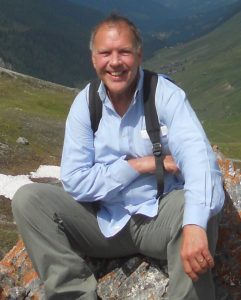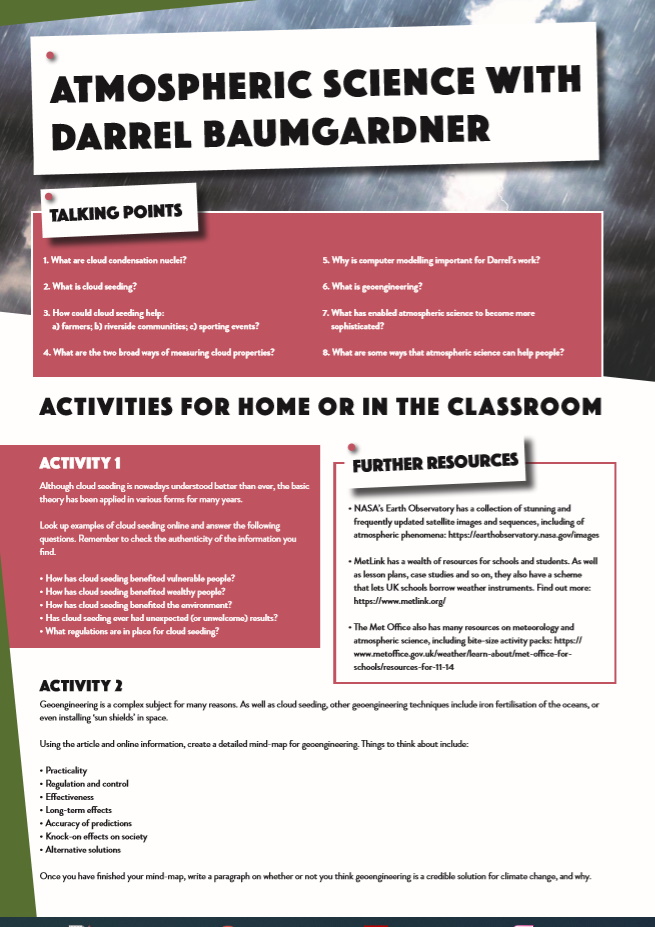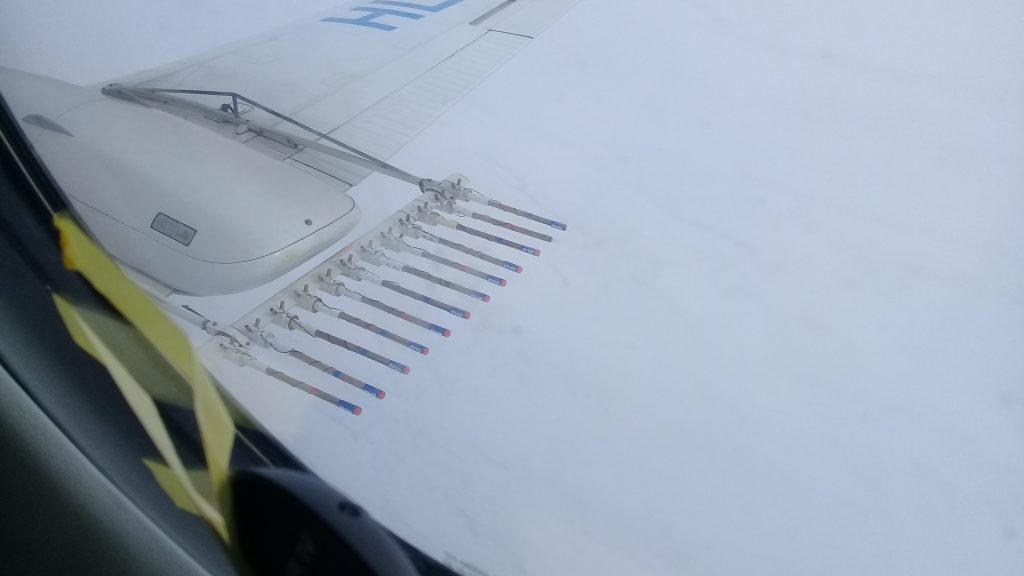Make it rain: the science behind altering the weather
Whenever humankind believes it has control over the natural world, the weather likes to prove us wrong. Storms, floods and droughts are just some of the weather patterns that can complicate or even threaten human life. We have increasingly sophisticated techniques for weather forecasting, but now scientists are looking even further: towards directly modifying the weather itself. Darrel Baumgardner, of The National Autonomous University of Mexico and Droplet Measurement Technologies, researches the intriguing technique of cloud seeding
Rain, or the lack of it, can cause problems. Too little rain can lead to droughts, which carries risks of crop failure and scarcity of drinking water. Too much rain can cause flooding and other forms of precipitation, such as hail, can cause physical damage to crops and property. Being able to influence when, where and how much rain falls could help prevent these negative effects.
Darrel Baumgardner has made a career of investigating clouds, not only how they form but also how humans can influence their formation. As well as working within academia, he is the founder and Chief Scientist at Droplet Measurement Technologies, which provides scientific instruments and expertise to researchers investigating aspects of cloud formation.
WHAT IS CLOUD SEEDING?
A key step in the water cycle is when water vapour in the atmosphere condenses into clouds, but this process can only occur with the presence of cloud condensation nuclei (CCN). These are essentially small particles of any number of substances, such as dust, soot or salt. To transition from a gas to a liquid, water molecules have to have something to cling onto, and CCN fulfil this function. Ice nuclei (IN) are the CCN equivalent for the formation of ice crystals in the atmosphere.
Cloud seeding is a human-made technique that adds extra CCN or IN into the atmosphere, which can either enhance or suppress precipitation, depending on how, when and where it’s done. This technique was famously used to keep the 2008 Beijing Olympics dry: rockets containing silver iodide particles (a type of IN) were fired into the atmosphere, intercepting incoming rainclouds and triggering premature showers before they could reach the capital.
HOW CAN YOU MEASURE SUCH A COMPLEX SYSTEM?
Atmospheric science is very complex, and scientists simply don’t have all the information required to guarantee that cloud seeding will have the intended effect. In some instances, cloud seeding can even lead to the opposite effect to that intended. There is also a certain lack of control. “Once the seeding material is released, there is nothing more that can be done,” says Darrel.
Measuring cloud properties, and how they react to different conditions, is essential. “There are two general types of instruments used to measure cloud properties,” says Darrel. The first are called disdrometers, and measure precipitation at the ground, including variables such as drop size, velocity and type of precipitation. The second type measures the properties of clouds themselves and are called spectrometers. By fixing a spectrometer to an aircraft or drone and flying it through a cloud, scientists can record cloud water content and a number of other variables. Similar measurements can also be taken from a great distance, using radar or even satellites.
HOW CAN SCIENTISTS MODEL CLOUD PROPERTIES?
When it comes to modelling clouds to predict how they will respond to seeding, there are many factors to take into account, and at many different scales. For instance, the nucleation of cloud droplets around a CCN happens at the microscopic level and in a matter of milliseconds, whereas the time to grow to visible raindrops (and eventually entire clouds) can take minutes to hours. When this is expanded to include the interconnected cloud formation over entire regions, it gets complicated very fast.
Reference
https://doi.org/10.33424/FUTURUM66
Rain, or the lack of it, can cause problems. Too little rain can lead to droughts, which carries risks of crop failure and scarcity of drinking water. Too much rain can cause flooding and other forms of precipitation, such as hail, can cause physical damage to crops and property. Being able to influence when, where and how much rain falls could help prevent these negative effects.
Darrel Baumgardner has made a career of investigating clouds, not only how they form but also how humans can influence their formation. As well as working within academia, he is the founder and Chief Scientist at Droplet Measurement Technologies, which provides scientific instruments and expertise to researchers investigating aspects of cloud formation.
WHAT IS CLOUD SEEDING?
A key step in the water cycle is when water vapour in the atmosphere condenses into clouds, but this process can only occur with the presence of cloud condensation nuclei (CCN). These are essentially small particles of any number of substances, such as dust, soot or salt. To transition from a gas to a liquid, water molecules have to have something to cling onto, and CCN fulfil this function. Ice nuclei (IN) are the CCN equivalent for the formation of ice crystals in the atmosphere.
Cloud seeding is a human-made technique that adds extra CCN or IN into the atmosphere, which can either enhance or suppress precipitation, depending on how, when and where it’s done. This technique was famously used to keep the 2008 Beijing Olympics dry: rockets containing silver iodide particles (a type of IN) were fired into the atmosphere, intercepting incoming rainclouds and triggering premature showers before they could reach the capital.
HOW CAN YOU MEASURE SUCH A COMPLEX SYSTEM?
Atmospheric science is very complex, and scientists simply don’t have all the information required to guarantee that cloud seeding will have the intended effect. In some instances, cloud seeding can even lead to the opposite effect to that intended. There is also a certain lack of control. “Once the seeding material is released, there is nothing more that can be done,” says Darrel.
Measuring cloud properties, and how they react to different conditions, is essential. “There are two general types of instruments used to measure cloud properties,” says Darrel. The first are called disdrometers, and measure precipitation at the ground, including variables such as drop size, velocity and type of precipitation. The second type measures the properties of clouds themselves and are called spectrometers. By fixing a spectrometer to an aircraft or drone and flying it through a cloud, scientists can record cloud water content and a number of other variables. Similar measurements can also be taken from a great distance, using radar or even satellites.
HOW CAN SCIENTISTS MODEL CLOUD PROPERTIES?
When it comes to modelling clouds to predict how they will respond to seeding, there are many factors to take into account, and at many different scales. For instance, the nucleation of cloud droplets around a CCN happens at the microscopic level and in a matter of milliseconds, whereas the time to grow to visible raindrops (and eventually entire clouds) can take minutes to hours. When this is expanded to include the interconnected cloud formation over entire regions, it gets complicated very fast.
However, this complexity is not insurmountable. “Modern computers have provided cloud modellers with the tools needed to create such models,” says Darrel. Model inputs include temperature, pressure, relative humidity, CCN and IN specific to a certain time and area, and then different seeding scenarios are run to see how they affect cloud properties. As with any model, it remains a simplified representation of the real world, so results aren’t perfect, but are getting more precise all the time.
THE BIGGER PICTURE
Cloud seeding could help mitigate against droughts, floods and even air pollution, but there are, perhaps, even bigger and more long-term applications. Geoengineering is the name given to techniques that aim not just to alter the weather but also the climate, to attempt to counteract the effects of climate change. When carried out at a global scale, cloud seeding and similar techniques are the most significant of these proposed measures.
“Geoengineering has the potential to offset the negative impacts of climate change,” says Darrel. For instance, one effect of climate change is the absorption of the sun’s heat by the oceans, which raises marine temperatures and can lead to ocean acidification – bad news for coral reefs and other underwater ecosystems. One project is looking into seeding stratus clouds over the Great Barrier Reef, which would deflect sunlight away from the sea’s surface and mitigate warming in that area. In theory, this practice could be carried out worldwide.
However, given the complex nature of atmospheric science, geoengineering efforts on a global scale pose many challenges for scientists. For example, stimulating rainfall to alleviate drought in one area could lead to extreme monsoons in another. Experts in this field are mindful that they need to consider the intricacies of the bigger picture. As Darrel explains, with processes such as cloud seeding, there is always the, “Goldilocks conundrum” and the challenge is in getting things ‘just right’. He adds, “As atmospheric scientists, we know that climate change is real.” Scientists like Darrel can make a huge difference to our world – will you be one of them?
TALK LIKE AN ATMOSPHERIC SCIENTIST
CLIMATE – the general weather conditions over a long period.
CLOUD CONDENSATION NUCLEI (CCN) – small particles around which water vapour condenses and ultimately forms clouds.
CLOUD SEEDING – intentionally adding CCN to the atmosphere to change precipitation patterns.
DISDROMETER – a ground-based instrument to measure precipitation properties.
GEOENGINEERING – deliberate, large-scale intervention in the Earth’s climate system, usually to mitigate climate change.
ICE NUCLEI (IN) – similar to CCN, particles in the atmosphere that ice crystals form around.
PRECIPITATION – water that falls from clouds to the ground, such as rain, hail, snow or sleet.
SPECTROMETER – an instrument that measures spectral properties, such as the reflective properties of cloud particles.
WEATHER – the state of the atmosphere of a particular area at a particular time.
 DARREL BAUMGARDNER
DARREL BAUMGARDNER
National Autonomous University of
Mexico and Chief Scientist at Droplet
Measurement Technologies, Longmont, Colorado, USA
FIELD OF RESEARCH: Atmospheric Science
RESEARCH PROJECT: Investigating how clouds form, and how we can influence their formation.
 DARREL BAUMGARDNER
DARREL BAUMGARDNER
National Autonomous University of
Mexico and Chief Scientist at Droplet
Measurement Technologies, Longmont, Colorado, USA
FIELD OF RESEARCH: Atmospheric Science
RESEARCH PROJECT: Investigating how clouds form, and how we can influence their formation.
ABOUT ATMOSPHERIC SCIENCE
WHAT IS ATMOSPHERIC SCIENCE?
Atmospheric science studies the layers of gas that surround the planet, specifically their chemistry and their dynamics. This includes interactions within the atmosphere, and between the atmosphere and other entities, such as the ocean or human activity.
Our atmosphere is the relatively thin barrier that separates the Earth’s surface from space. “Although the atmosphere makes up a small fraction of the Earth’s volume, it is critical to life, not only for the oxygen we need but also for the hydrological cycle.” The science that attempts to explain it is complex and detailed, but has come on in leaps and bounds in recent decades.
HOW HAS THE FIELD CHANGED OVER THE YEARS?
“We are now able to make faster and more accurate measurements with much smaller instruments,” says Darrel. “We can also run computers hundreds of times more powerful than just a few decades ago.” These huge advancements mean that understanding of atmospheric science is accelerating. “We know so much more about how clouds evolve than we did 50 years ago, but we still have a long way to go before we can truly ‘control’ weather,” says Darrel.
WHAT ARE THE REAL-WORLD APPLICATIONS OF ATMOSPHERIC SCIENCE?
Weather forecasting, although it might seem a rather bland aspect of everyday life, has the potential to save countless lives. Forecasting tropical storms, tornados or hurricanes, for instance, can help people prepare and safeguard themselves and their livelihoods. Atmospheric science also underpins much of what we know about climate change. “We know that climate change is real and is the greatest danger that the world faces today,” says Darrel. Not only does atmospheric science provide us with much of the data about climate change – its predicted evolution and effects –, it also suggests ways we could protect ourselves against it.
Atmospheric science has a huge amount to teach us about the present and the future of our planet, and a career in it could have far-reaching positive impacts for society.
HOW TO BECOME AN ATMOSPHERIC SCIENTIST
• According to NASA, a career in atmospheric science could begin with an undergraduate degree in meteorology, physics, chemistry, geography, mathematics, engineering or computer science.
• The Royal Meteorological Society has a list of UK universities that offer qualifications related to atmospheric science: https://www.rmets.org/courses
• According to College Factual, the top three universities in the USA for studying atmospheric science and meteorology are: Texas A&M University – College Station; University of California – Los Angeles; and University of Oklahoma Norman Campus
• Darrel highlights the University of Washington, the University of Wyoming, the Massachusetts Institute of Technology (MIT), Colorado State University and North Carolina State University as establishments to consider.
• According to Career Explorer, the average salary for an atmospheric scientist in the USA is about $94k.
HOW DID DARREL BAUMGARDNER BECOME AN ATMOSPHERIC SCIENTIST?
WHAT WERE YOUR INTERESTS AS A CHILD?
I was always curious as a child. I had my own chemistry set, Meccano, and lots of other educational toys that were available at that time. I enjoyed exploding things, taking things apart and putting them back together again. For a time, I was interested in becoming a writer, but decided to become a physicist at high school.
DID YOUR TEACHERS INFLUENCE YOUR DECISIONS?
I was lucky to have several inspirational teachers. My math teachers and my senior year physics teacher energised me with their enthusiasm for their subjects. A skilled teacher is driven by their curiosity and is someone who students want to emulate.
WHAT ARE YOU MOST PROUD OF FROM YOUR CAREER?
I have been a university professor for fourteen years and a research scientist for forty. I also have a patented design: the Backscatter Cloudprobe with Polarisation Detection. I have won an award for being the most cited Latin American scientist, with over 200 high-impact publications. I also founded my own tech company that does atmospheric research, which is still going strong after thirty years!
HOW DO YOUR ROLES IN ACADEMIA AND INDUSTRY COMPLEMENT EACH OTHER?
Many of my company’s clients are academics, and I interact with them and their students. I often visit universities and give classes in cloud and aerosol physics, as well as teaching measurement and data analysis techniques.
WHAT’S NEXT?
I have too many goals to name! I hope to improve techniques for measuring cloud ice crystal properties, and to develop a better method for identifying pollen particles in real time.
Darrel recommends taking:
• Maths
• Chemistry
• Physics
• Environmental sciences
Other subjects such as geography and computer science could also be very useful.
DARREL’S TOP TIPS FOR STUDENTS
01 – Follow your instincts, and don’t doubt yourself. Once you have made a decision, don’t look backwards or regret your choice.
02 – Attributes such as curiosity, problem solving, creativity and exploring my own wild ideas have hugely helped my scientific career.
03 – Let your creativity grow and don’t limit yourself. Being able to write well is essential, so read widely: history, literature, fiction, non-fiction. Music can also provide a great creative outlet.




